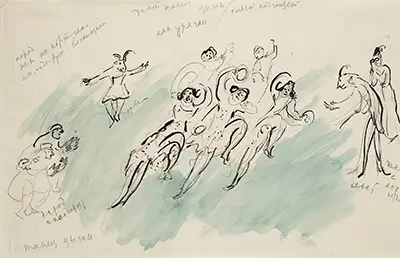The artist mainly used drawing as a means to prepare later artworks, be them paintings or his series of lithographs. It was rare for him to present a completed artwork as a drawing, but did do this on occasion. He would regularly experiment across his career and so there are no real rules about his work as such, but periods in which he put his focus on particular things. Chagall was also known as something of a perfectionist and so he would put great importance on correctly planning each artwork so that the final result would be to as high a standard as possible. For this reason he would also make use of specialists to help guide his work, but with drawing he was confident enough to go alone once he had gone through his art education as a young man.
He would learn the techniques of drawing from a young age, just as most students would do. This is generally the focus initially, with the likes of painting and sculpture techniques added later on. There is an important base of knowledge which can be learnt through sketching and so it makes an ideal starting point, with the resources also much easier to source and cheaper. It tends not to take long before ambitious young artists look to try out new ideas and mediums, but drawing often remains an important part of their toolset, and something that can be called upon throughout their career. It is also a flexible medium which can be used in conjunction with other tools, such as laying out a composition on canvas prior to the application of oils, for example. Today the full breadth of his career has been studied in detail, allowing us to appreciate the variety of work that he produced.
It was the figurative work of this artist which made his oeuvre so memorable. You will find all manner of different characters floating around in the world created by Chagall himself. Viewing his works is a little like entering his sleeping mind and witnessing his dreams. Behind these figurative portraits, lied his sketching talents and we have uncovered hundreds of examples of him practicing this challenging art using fairly simple tools such as just a few pencils. It was at that stage that the hard work was done, delivering precise and accurate characters which then allowed the artist to concentrate on making use of his imagination as well as considering bright colour tones to provide the final impact. It is therefore important to study these sketches in order to truly understand the developments made across his career, which were particularly important in his early years where the biggest advancements were made.
One can see the final result of this hard work by examining some of Chagall's most famous paintings. La Mariee and The Promenade, for example, display these charming figures which are almost cartoon-like in appearance. This was a part of the dreamy world in which characters could float around. The use of items from reality in unrealistic scenarios is how many claimed Chagall to be a Surrealist artist, though he directly rejected this comparison. He wanted to just be considered in his own unique category though since his passing a number of others have worked similarly, clearly inspired by his highly prized oeuvre. We found something similar with the career of Georgia O'Keeffe who was long introduced as an impressive female artist, when really she only wanted to be known as an artist and judged in the same way as her male counterparts. Today, this is probably more the case as a greater diversity exists within curated exhibitions within the western world.
Drawings Mediums used by Marc Chagall
Chagall would sometimes start with pencil before then applying pen over the top in order to add greater contrast - you can see an example of that with the image included in this page. He would also use simple washes for colour in a subtle manner, or alternatively go for a bolder use of watercolours instead. For study drawings he might also leave small notes around the composition which was to record certain thoughts that came to him whilst considering the final oil piece. This was something that artists have been doing for centuries, with even the likes of Da Vinci and Michelangelo leaving related thoughts on their sketches back in the Italian Renaissance. When we discover comments written around an artwork, it is normally a sign that the piece was never really intended for public consumption but the value of these artists' works has ensured that many have still be collected anyway in the years that followed. Anything connected to Chagall now commands a large value, even for his study pieces such as the one displayed here.
Chagall was a true modern artist who would work from his emotions, with the technical training that he had from an early age allowing him to focus on creativity rather than precision. This was key to his success and he worked in a style that many can instantly recognise as his own, with no-one else producing anything similar until after his career had finished. We see today several painters who love his work and choose to continue his legacy in their own careers, but they will never achieve quite the same heights as Chagall who was the true innovator. There were a number of others across the 20th century who brought new ideas into the art world and helped to refresh its direction into something that the public could better grasp and appreciate. Whilst some of the abstract works can be lost on the public, the likes of Chagall would achieve a delightful balance between reality and the imagined world, and his use of colour helped to provide the greater impact possible.
